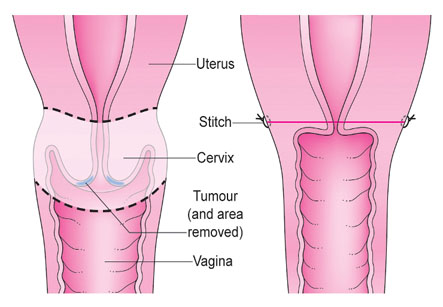Trachelectomy
Introduction
A radical trachelectomy is a surgical procedure to remove cancer from the cervix (neck of the womb).
It involves removal of the cervix and the upper third part of the vagina. The parametrial tissue
(tissue surrounding the lower end of the uterus) and the pelvic lymph nodes are also removed.
This surgery is only performed on women with early stage of cervical cancer, who wish to preserve their ability to become pregnant in the future.
Before considering this surgery, the surgeons will need to perform some investigations to check that you are suitable for this procedure.
First the doctor examines the cervix and inside the bladder, whilst the patient is asleep under a general anesthetic. This is called as Examination Under Anesthesia (EUA) and cystoscopy.
A Magnetic Resonance Imaging (MRI) scan is performed.
The results of these investigations are reviewed by a team of senior doctors to decide whether or not you are suitable for this procedure.
We have all the information you need about public and private clinics and hospitals that provide gynaecological treatment in Iran

Risks specific to trachelectomy include:
• Lymphoedema – This can occur when the lymphatic drainage system becomes blocked and surrounding tissues may swell. This can cause swelling in the lower body and legs, skin problems, pain and discomfort. This can become permanent and can happen months or years after surgery.
• Lymphocysts or lymphoceles – these are swellings filled with fluid which can develop after the operation in the abdomen. These are often naturally re-absorbed by the body, but if they are larger or causing discomfort, the surgeon may drain them by a needle.
• Bladder problems – Difficulty in emptying the bladder can occur after this surgery and may need catheterization for several weeks.
• Problems with menstruation – some women may find that the blood from their menstrual cycle becomes trapped inside the womb as the entrance is too small for it to drain fully, and it needs to be removed by opening the entrance to the womb.
• Very rare risk of death
Procedure:
This surgery is only performed on women with early stage of cervical cancer, who wish to preserve their ability to become pregnant in the future.
The cervix and the parametrial tissue are removed through the vagina and the pelvic lymph nodes are removed through an opening made in the abdomen or laparoscopically through multiple small incisions.
A large permanent stitch is inserted around the opening of the uterus which is strong enough to hold a pregnancy. This stitch holds the opening of the uterus together, but still allows for menstruation.
You might have a pain relieving pump. There are two types:
1. An epidural pump, which gives pain relieving drugs into the back, and makes the legs heavy and numb
2. A PCA (patient controlled analgesia) which allows controlling the drugs by the patient. The nurse will explain how to use this pump.
The first day after the operation
• Patient should sit up-right out of bed. This lets the lungs open up fully and makes it easier to cough and helps to prevent a chest infection.
• Start moving around as soon as possible which improves the blood circulation and along with anti-embolic stockings, it can help prevent blood clots (Deep vein thrombosis). Heparin injection can also be given for prevention of clotting.
• If you smoke, it is important to stop smoking for at least 24 hours before the operation to reduce the risk of chest problems and to help the body cope with the general anaesthetic. Smoking can also delay wound healing.
After a few days of operation:
• The physiotherapist will show the easiest way to start moving again and willexplain about doing pelvic floor exercises.
• Drinking plenty of fluids and walking around will also help the bowels to start working again.
• The catheter will also be removed after five days, which allows the nerves around the bladder time to heal, so that emptying of bladder can be complete.
Going home
• Patient usually stays in hospital for about three to five days after the operation.
• It is important to follow all the advice given by the doctor when leaving the ward. Patient should continue to do the pelvic floor exercises. This can help to prevent problems of urinary incontinence.
• About 10 to 14 days after the operation, pinkish or brown discharge can occur from the vagina. This will last for a few days and Is a normal part of healing.
Cervical screening tests:
Patient still needs to have screening tests (smear tests) as a part of the routine follow-up, even after the cervix has been totally removed.
Results:
Although the long-term results of the trachelectomy are not yet known, but the initial results in terms of fertility and cure rates appear to be promising. However, a complete hysterectomy is still considered to be the best chance of cure.